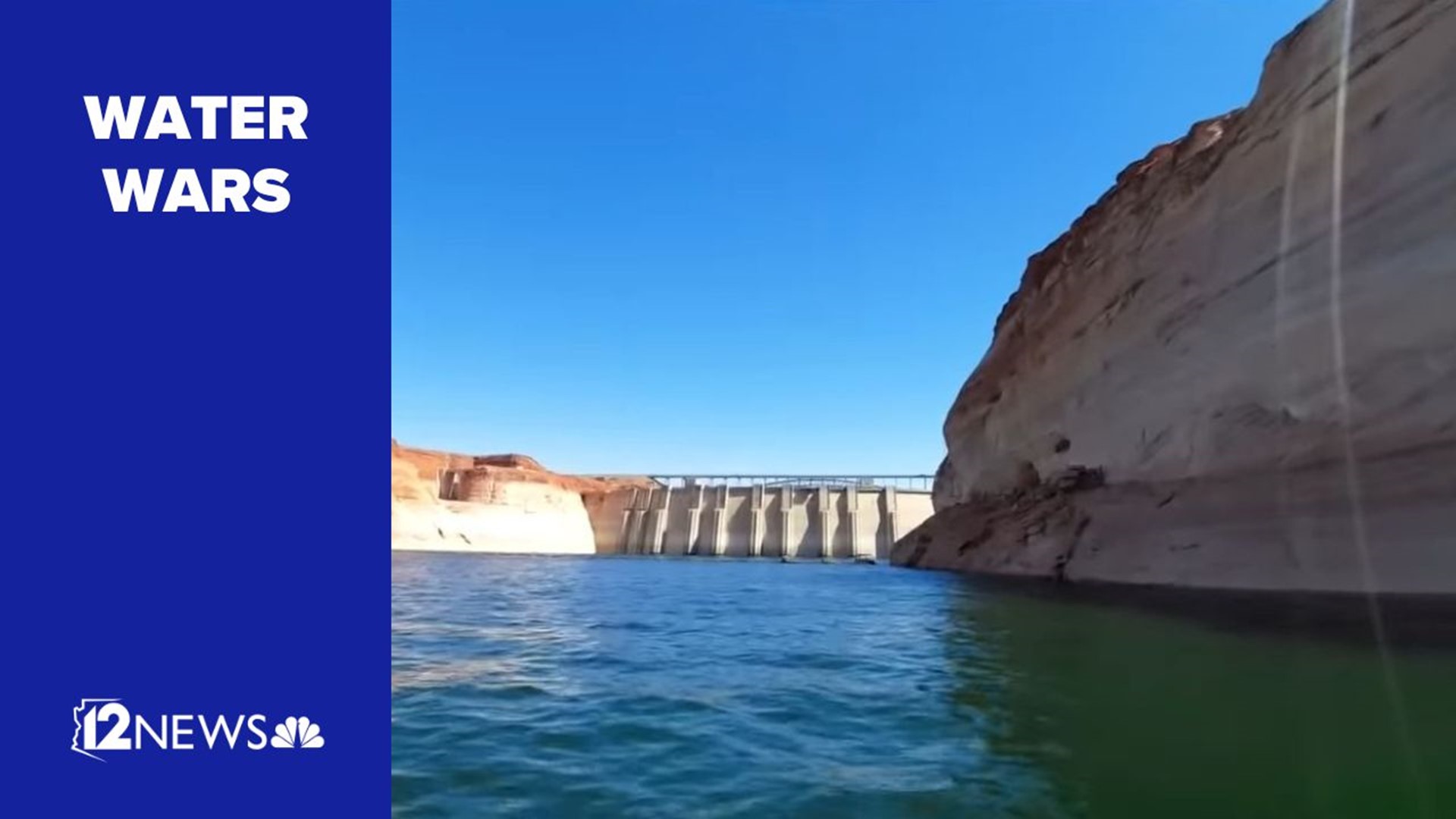ARIZONA, USA — Editor's note: The above video aired during a previous broadcast.
Arizona's farmland is set to get drier after the federal Bureau of Reclamation announced Tuesday the state must cut back 21% of its Colorado River water supply.
Federal officials will reportedly reduce Arizona's river water usage by 592,000 acre-feet. One acre-foot of water would generally supply three average Phoenix households with water for a year.
The announcement comes off the back of the bureau's latest Colorado River Basin study that projected Lake Mead would reach its lowest elevation ever in Jan. 2023, triggering the lake's first-ever Tier 2a shortage.
The first shortage Lake Mead declared last August was at Tier 1, which restricted Arizona water by 500,000 acres. The next shortage to be declared was Tier 2, which would have restricted a further 80,000 acres. Officials jumped to a Tier 2a shortage on Tuesday, combining the 80,000 cut acres with another 500,000 acres, plus some.
"Over the last two decades, Department leaders have engaged with Colorado River Basin partners on various drought response operations," the bureau said in a press release. "However, given that water levels continue to decline, additional action is needed to protect the System."
The 21% reduction is much more dire than the original 15% reduction the bureau told Arizona and six other Southwest states they had to prepare for in June. The feds told states they would step in and impose restrictions themselves if that deadline wasn't met.
PREVIOUS COVERAGE: Colorado River cuts expected for Arizona, Nevada and Mexico
State officials react to the announcement
Officials at the Arizona Department of Water Resources and the Central Arizona Project (CAP) canal said that they did meet the deadline, but their collaborative proposal with Nevada was rejected by the federal officials.
"It is unacceptable for Arizona to continue to carry a disproportionate burden of reductions for the benefit of others who have not contributed," ADWR and CAP officials said in a press release. "Arizona is committed to work toward a comprehensive plan that assures protection of the system through equitable contributions from all water users."
Arizona Senator Mark Kelly agreed with the sentiment in a press release, saying the Grand Canyon State has already "put more wet water on the table than any other state, while other parties have offered a fraction of the same amount." The state has the second-highest allocation of the river's water at 2.8 million acre-feet per year, behind California at 4.4 million acre-feet.
"[Water restriction] options should recognize and account for the early and consistent contributions that Arizona has made and will continue to make to preserve water levels in Lake Mead and Lake Powell," Kelly said.
Arizona farmers expected to take brunt of water cuts
Farmers across Arizona are expected to be hit the hardest as agriculture uses the majority of the state's river water allocation at an estimated 527,000 acre-feet per year. Water officials previously told 12News they expect two-thirds of the river water that goes towards state farming to be cut.
See a full breakdown of the state's latest water usage numbers here:
Arizona's agriculture industry has had a troublesome history of overusing water. Before using Colorado River water, farmers relied on groundwater and almost drained the state dry. The crisis was seemingly averted in 1973 with the formation of the CAP canal.
"A lot of agriculture in the state was very reliant on well water before we got the CAP canal," Kyl Center for Water Policy Director Sarah Porter previously told 12News. "It was broadly understood that well water was a finite resource and we were going to be in trouble."
The overuse of well water led to farmers giving up their CAP rights to cities in exchange for those cities subsidizing the water through urban property taxes.
Nearly 50 years later, farmers will have to face the consequences of that deal as another water crisis looms.
The faucets of Arizona's city residents will continue to run, but the shortage will be felt by residents in almost every other way.
“Agriculture will be impacted,” CAP General Manager Ted Cooke previously told 12News. “There still will be farming, but it will be less and some of them will go back to groundwater.”
It will cost more to grow things in Arizona as water runs dry. That has a trickle-down effect on the products that are grown on farms and industries that depend on it, like ranching.
Cities don't expect pipes to run dry
The next biggest user is the state's municipal water users at just over 500,000 acre-feet per year. Glendale's water resource manager, Drew Swieczkowski, previously told 12News he expects Valley cities to get half as much river water next year.
PREVIOUS COVERAGE: Arizona's cities may see 'huge' water cutbacks soon. Here's what that means for Valley residents
The river currently accounts for:
- 65% of water used in Scottsdale
- 53% in Peoria
- 45% in Glendale
- 40% in Phoenix
- 29% in Gilbert
“We can do it, definitely," Swieczkowski said. "It just takes moving water around and using more resources, but I think all the cities are saying, ‘Yeah, we can still supply water. It doesn’t mean your taps are going to run dry.'”
Water Wars
Water levels are dwindling across the Southwest as the megadrought continues. Here's how Arizona and local communities are being affected.

